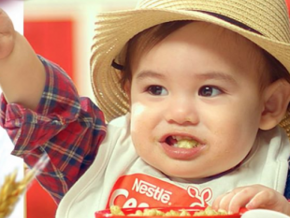
Reading your Child’s Hunger and Fullness Cues
At this stage, your baby’s menu may have expanded to include more cereals and baby food varieties. His excitement over food can turn mealtime into a fun, playful experience for the both of you. Take advantage of this moment. Feeding your baby is a commitment and an opportunity to bond with him.
Know when to feed your 6-to-7-Month-Old Child
At this stage, your baby’s menu may have expanded to include more cereals and baby food varieties. His excitement over food can turn mealtime into a fun, playful experience for the both of you. Take advantage of this moment. Feeding your baby is a commitment and an opportunity to bond with him.
Hunger Signs:
- Still cries when hungry or wants food
- Reaches for spoonful of food
- Opens mouth and leans toward bowl or spoon
- Stares at you while eating as if to say “Hindi pa po ako busog, Mama!”
- Moves head toward spoon or tries to direct food towards mouth
Spot it when he’s full
When you’re baby is already spoon-feeding, your baby makes his wishes known when he’s full.
Fullness Cues:
- Leans away from the food and may push the spoon away
- Clenches his mouth shut and doesn’t allow you to feed him
- Spits out food that he likes.
- Pushes away the bowl or whatever food is there
- Slows down the pace, gets distracted and looks elsewhere
TOP TIP! Don’t force more food if your baby doesn’t want to eat anymore. Respect the fact that he knows when he’s full.
Know when to feed baby, 8 to 12-months old
It’s important to recognize hunger and fullness cues because a baby’s tummy is small. Although your baby’s portions may seem tiny, he eats less, but he eats more frequently than you do. Reminder --- You are learning his cues for hunger and fullness, and he is learning how to respond to your behavior.
Hunger signs:
- Kicking his legs and banging on the high chair tray says “Konting-bilis lang sa food, Mommy!”
- Putting fingers in his mouth and fussing lets you know he is hungry
- Excitedly watching as you prepare his food and show it to him
- Reaching for food when he sees it says “Kakain na!”
- Eating with full attention on you and awaiting the next bite
- Pointing at food
- Gets excited when food is offered.
- Showing desire for specific food with words or sounds.
TOP TIP! It is your job as parent to provide baby with healthy food. It is your child’s job to decide what and how much to eat.
Recognize it when he’s full
Baby usually makes his wishes known when he is full.
Fullness Cues:
- Turns his head away from the spoon or food
- Shuts his mouth tight and shakes his head “no” to say he’s had enough
- Pushes away his bowl and tries to knock the spoon from your hand
- Not interested in food, and looks away from you
- Eating slows down
Co-written with Kate Perales, RND
References:
Crow RA. An ethological study of the development of infant feeding. Journal of Advanced Nursing. 1977;2:99–109.
Korner AF, Chuck B, Dontchos S. Organismic determinants of spontaneous oral behavior in neonates. Child Development. 1968;39(4):1145–1157.
Morris SS, Rogers CS, Taper LJ. Care-giving behaviors in feeding 3-, 13-, and 23-month-old infants. Nutrition and Behavior. 1983;1:147–156.
Butte NF, Fox MK, Briefel RR, Siega-Riz AM, Dwyer JT, Deming DM, Reidy KC. Nutrient intakes of US infants, toddlers, and pre-schoolers meet or exceed dietary reference intakes. J Am Diet Assoc. 2010;110(12 Suppl):S27-37.
Siega-Riz AM, Deming DM, Reidy KC, Fox MK, Condon E, Briefel RR. Food consumption patterns of infants and toddlers: where are we now? J Am Diet Assoc. 2010;110(12 Suppl):S38-51.
American Academy of Pediatrics. Bright Futures Nutrition, 3rd ed. Elk Grove Village, IL: American Academy of Pediatrics, 2011.
Maier A, Chabanet C, Schaal B, Issanchou S, Leathwood P. Effects of repeated exposure on acceptance on initially disliked vegetables in 7-month old infants. Food Quality and Preference. 2007;18:1023




























